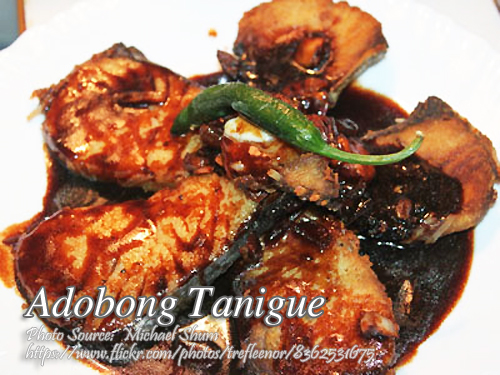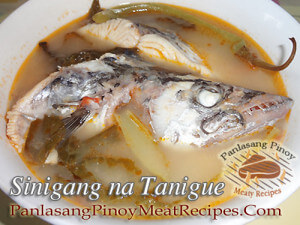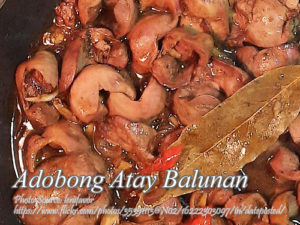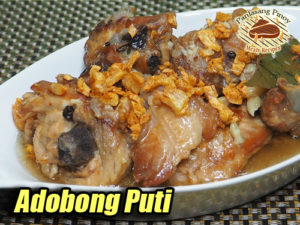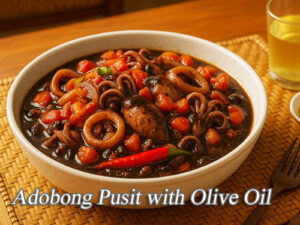Adobong tanigue is another simple adobo dish using tanigue steaks or Spanish mackerel. Like all other fish steaks, since it is flaky, just be careful not to break the steaks while cooking. The extra step of frying the tanigue steaks helps to make the fish intact while cooking so it will break to pieces easily.
A Family Favorite: How Adobong Tanigue Became Our Go-To Dish
Growing up in Cavite, weekends were always something to look forward to. My Lolo Andres would wake up early to go to the wet market, and he’d almost always come back with fresh tanigue steaks wrapped in old newspaper. He’d call out to my Lola Ester, who already had the soy sauce, vinegar, and spices ready. “Mag-adobo tayo ngayon,” he’d announce with a big smile. That’s how adobong tanigue became a staple on our family table—simple, hearty, and packed with memories.
The Secret to Perfect Adobong Tanigue
The thing about cooking adobong tanigue is that it’s deceptively simple. My Tito Boy taught me that the key is in the frying. Before simmering the fish in the sauce, you first fry the tanigue steaks until they turn golden brown. This extra step might seem like more work, but it makes all the difference. By lightly crisping the outside, you create a protective layer that helps keep the fish intact during simmering. If you skip this, the steaks could easily flake apart and turn into a messy adobo stew.
Another tip I learned from Ate Liza is to be very gentle when stirring. Spanish mackerel has a flaky texture, so a heavy hand can break the steaks. She would always say, “Hinay-hinay lang,” as she used a wide wooden spatula to slowly coat the fish with the flavorful sauce.
What Makes Adobong Tanigue Special
Adobo, in all its variations, is considered the unofficial national dish of the Philippines. The method of cooking in vinegar and soy sauce was originally a way to preserve food before refrigeration became common. Over time, every region and even every household has developed its own version. While pork and chicken are the usual stars of adobo, using fish like tanigue brings a lighter, fresher twist to the beloved classic.
Spanish mackerel, or “tanigue,” is a firm, meaty fish that’s perfect for adobo. It holds up well to frying and simmering, and its natural richness pairs beautifully with the tangy-sweet adobo sauce. Plus, it’s quick to cook, making it an ideal option for busy weekdays or sudden cravings.
Cooking Spanish Mackerel Adobo at Home
When my cousin Mark visited from Zambales, he brought with him some freshly caught tanigue. We decided to make adobong tanigue right there in the beach house kitchen. First, we seasoned the fish lightly and fried it just until it turned a lovely golden brown. In the same pan, we sauteed garlic, onion, and ginger until the kitchen smelled absolutely heavenly.
Adding the soy sauce, a hint of brown sugar, a few laurel leaves, and cracked black pepper created a sauce that was both savory and slightly sweet. After letting it simmer to blend the flavors, we gently placed the fried fish back in the pan. Using a spoon, I carefully basted the steaks with the sauce instead of stirring them vigorously. This technique kept the steaks whole and juicy, soaking up all the delicious flavors.
We served the adobong tanigue hot, alongside steaming cups of garlic rice. The tangy, garlicky sauce draped over the flaky fish was pure comfort in every bite.
Food for Thought: A Little History of Adobo
The term “adobo” comes from the Spanish word “adobar,” which means “to marinate.” However, Filipino adobo existed long before the Spaniards arrived. Early Filipinos were already cooking meat and seafood in vinegar and salt to prolong shelf life. The Spanish colonizers merely gave it a name.
Interestingly, while pork and chicken dominate the adobo landscape, coastal communities have long favored fish adobo. Using seafood like tanigue not only made sense geographically but also showcased the incredible bounty of the Philippine seas.
Why You Should Try Adobong Tanigue
If you’re new to Filipino cooking, adobong tanigue is a fantastic starting point. It’s beginner-friendly, requiring only a few basic ingredients and simple techniques. Plus, the frying step ensures your fish will stay beautiful and delicious, even if you’re not an expert in the kitchen.
Whether you’re recreating a childhood memory like me or trying Filipino food for the first time, this dish is sure to win you over. And who knows? Maybe one day you’ll be passing the recipe down to your own family, just like my Lolo Andres did.
Adobong tanigue isn’t just a dish—it’s a little piece of home, served on a plate.
How to Cook Adobong Tanigue (Spanish Mackerel Adobo)
Ingredients
- 1/2 kilo Tanigue steaks
- 1 pc medium size onion
- 3 cloves garlic crushed
- 1 inch ginger chopped
- 1/4 cup soy sauce
- 1/4 cup vinegar
- 1 tsp. ground black pepper
- 2 pcs laurel leaves
- 1 tsp brown sugar
- Cooking oil
Instructions
How to cook Adobong Tanigue:
- Fry tanigue steaks until golden brown. Set aside.
- In an empty pan pour 1 tablespoon cooking oil and saute garlic, onion and ginger.
- When garlic turns a little brown and onion is already cooked, add soy sauce, laurel leaves, brown sugar and pepper.
- Let it simmer for 1 to 2 minutes then add the fried tanigue steaks and gently stir cook until the sauce sticks with the fish.
- Just be careful not to break the tanigue steaks when stirring. Serve hot.
Notes
Cooking Tips:
Fry the Tanigue Steaks First
Before simmering in the sauce, lightly fry the tanigue steaks until golden brown. This step seals the surface of the fish, helping it stay firm and intact during cooking. Skipping this step can cause the delicate fish to flake and break apart in the sauce.Stir Gently to Keep the Fish Whole
When adding the fried steaks back into the sauce, use a wide spatula and a slow, careful motion. Stirring too hard or too often can cause the fish to fall apart into pieces. Gently spooning the sauce over the fish instead of stirring works best for maintaining the steaks' shape.Let the Sauce Reduce to Intensify Flavor Allow the adobo sauce to simmer until it slightly thickens and clings to the fish. This reduction deepens the savory, tangy-sweet flavors that make adobong tanigue so delicious. Rushing this process can leave the sauce watery and the dish tasting flat.
